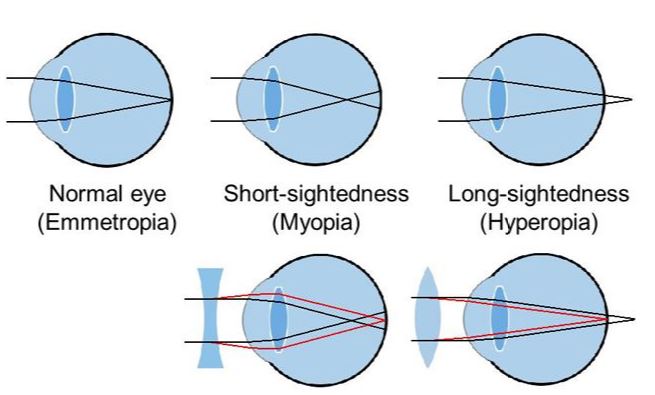
Astigmatism and Myopia, knowing the differences between these two will not only benefit you, your relatives or friends but will give you an upper hand in making meaningful decision when it comes to eye health. They both fall under a category of vision disorders known as Refractive error because they affect how the eyes bend or “refract” light.
Refractive Error
A refractive error of the eyes refers to a vision condition where the eye cannot properly focus light onto the retina, resulting in blurred or distorted vision. The human eye can be likened to a camera with the focusing elements of the eye being the cornea and the crystalline lens and the ‘film’ is the retina (a light-sensitive layer of tissue lying at the back of the eye). If light from an object passes through the transparent cornea and crystalline lens, it must fall exactly on the retina. When this feat is not achieved then the individual has a refractive error which can be myopia (near-sightedness), hypermetropia (far-sightedness), or Astigmatism.

What is Astigmatism?
Astigmatism is when the cornea (transparent tissue covering the entrance of the eye) is unevenly shaped or the crystalline lens of the eye is unevenly shaped resulting in an image of an object being focused at different points on the retina rather than at one point. The cornea is shaped more like a rugby ball (prolate spheroid) rather than being perfectly round like a basketball and in astigmatism this shape is irregular on the surface of the cornea. Astigmatism can cause blurry or distorted vision and, in some circumstances, cause headaches.
The surface of the cornea is important in this condition because the cornea surface does most of the refraction (the bending of light) in the human eye. The ‘relaxed’ eye has an approximate dioptric power of +60.00, the surface of the cornea holds +48 Diopters of this corneal power and the posterior surface has -5.00 Diopters making a total of +43 Diopters. The rest of the refraction is done mainly by the crystalline lens and so if the cornea or lens is irregularly shaped then astigmatism occurs.

Causes of Astigmatism
- Hereditary: People are born with the condition. If you have a family history of astigmatism then you have a higher chance of getting astigmatism as well.
- Growth or Mass: When there is a growth like pterygium or a mass like chalazion on the cornea for a long period of time, astigmatism can happen
- Keratoconus: A relatively rare degenerating condition in which the cornea becomes progressively thinner and cone-shaped. It typically starts when one is a teenager, and it usually continues to get worse until about age 40 or a little beyond that. Since this condition affects the cornea it easily causes astigmatism.
- Injury or Surgeries: Any injury or surgery that affects the shape of the cornea or the crystalline
Management
- Eyeglasses: People with astigmatism can be given glasses with ‘cylinders’ as correction. Mind you, the glasses won’t permanently ‘cure’ the astigmatism but would rather aid their vision.
- Contact Lenses: These can also be given as management for some individuals rather than eyeglasses. Contact lenses may provide some benefits like a wider field of view.
- Orthokeratology: This procedure entails placing a sequence of rigid contact lenses onto the cornea to alter its shape. The patient wears these lenses for short durations, such as overnight, before taking them out.
- LASIK or PRK Surgeries: Some individuals can have their astigmatism corrected through refractive surgeries like LASIK (laser in situ keratomileusis) or PRK (photorefractive keratectomy).
What is Myopia?
Myopia occurs when the eyeball is either too long or the cornea is too curved or steeped, causing light rays to focus in front of the retina instead of directly on the retina. In this condition, objects which are closer appear clearer whereas distant objects appear blurry. According to the American Optometric Association, myopia affects nearly 30% of the U.S. population and it is expected about half of the world’s population will be myopic by the year 2050. Myopia may cause headaches, eyestrain, or one’s vision to blur to the extent that they have to squint to see properly.

Causes of Myopia
- Hereditary: If you have a family history of myopia then your chances of being myopic are higher.
- Eyeball Growth: Myopia is often associated with the elongation of the eyeball, causing the image of an object to fall in front of the retina instead of directly on it. The exact reasons for abnormal eye growth are not fully understood, but genetics play a role. The eyeball is expected to be 23mm-24mm long on average, if it gets longer than 24mm then myopia can occur.
- Environmental Factors: Some studies suggest that spending more time outdoors, especially during childhood, may have a protective effect against the development of myopia. Also, activities that require intense focusing on close objects, such as reading, using electronic devices, and prolonged near work, can play a part in the development and progression of myopia.
- Age: Myopia usually starts from childhood and tends to progress over the years. It may stabilize in early adulthood but can continue to worsen throughout one’s life.
- Associated Health Conditions: Certain health conditions, such as diabetes and cataracts, can increase the risk of developing myopia.
Moreover, there are cases where individuals may develop myopia without any obvious identifiable cause.
Management
- Eyeglasses: For most individuals, a simple choice of eyeglasses is enough to aid their vision. It must be noted that the glasses won’t provide a permanent ‘cure’ for astigmatism; instead, they will aid one’s vision. Usually, a single-vision lens is prescribed to provide clear vision at all distances.
- Contact Lenses: In some myopic patients, contact lenses may be a good alternative to glasses as they provide a clearer and wider field of view. However, it requires adequate evaluation and care to avoid infections since it is placed directly on the eye, unlike glasses.
- Orthokeratology: Also known as Ortho-K or corneal refractive therapy (CRT), involves fitting the cornea with a series of rigid contact lenses to reshape its curvature. These lenses are worn for brief periods, typically overnight, and then removed.
- Vision Therapy: For individuals experiencing stress-induced myopia, vision therapy is a potential solution. This approach is suitable for those with blurry distance vision resulting from muscle spasms affecting eye focusing. Engaging in a range of eye exercises can enhance the ability to focus and restore clear distance vision.
- Surgeries: Refractive surgeries such as LASIK (laser in situ keratomileusis) or PRK (photorefractive keratectomy) can be considered a possible treatment in for myopia in adults. In PRK, a laser is utilized to extract a thin layer of tissue from the cornea’s surface, altering its shape to refract light entering the eye. LASIK, on the other hand, targets tissue from the inner corneal layers without affecting the surface. This is achieved by lifting and folding a portion of the outer corneal surface to access the inner tissue. A laser is then employed to precisely remove the necessary amount of corneal tissue for reshaping the eye. Subsequently, the flap of outer tissue is repositioned to facilitate healing. Also, clear lens extraction with intraocular lens implantation can be done for myopia correction. This procedure is similar to cataract surgery but the crystalline lens is clear and has not cataract.
Astigmatism and Myopia: The differences
Despite having numerous similarities, especially in management, astigmatism and myopia have some differences as well.
Eye shape: Both astigmatism and myopia occur when there is a deviation from the normal eye shape but the kind of shape is what matters. In astigmatism, the cornea or crystalline lens is irregularly shaped than the normal ‘rugby’ (prolate spheroid) shape whereas in myopia the eyeball itself is too long or the cornea is too steep or curved which results in light being focused in front of the retina.
Prevalence: Visual problems resulting from uncorrected refractive errors are common occurrences in most parts of the world. However, the most common refractive error is astigmatism, this is confirmed in a 2017 meta-analysis research by Hashemi et al. Myopia is also common but not as astigmatism. Myopia is currently on the rise, with high prevalence recorded in some parts of East and South-East Asia.
Vision: In both astigmatism and myopia, vision may be blurred but astigmatism may cause blurred images at both distance and near whereas myopia causes blurred vision at mostly distance.
Severity: Astigmatism and myopia can both be severe in one form or the other. But unlike astigmatism, degenerating myopia can result in more significant vision loss conditions such as retinal detachment, glaucoma, or macular degeneration.




